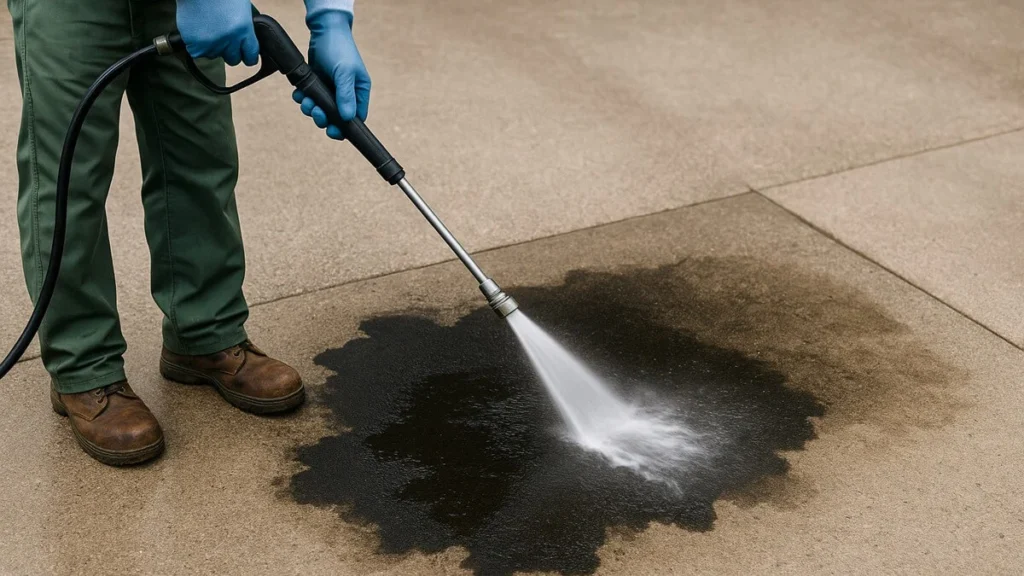How to Get Oil Out of Concrete?


Accidental oil spills on your driveway or garage floor can look permanent, but by learning how to get oil out of concrete you can be saved from expensive repairs. Remove stains effectively requires, careful preparation, the right cleaning agents, scrubbing techniques, thorough rinsing, and long-term protection. Whether you’re dealing with a small, fresh drip or old, ground-in grease, this guide gives you straightforward steps you can follow at home to restore your concrete surfaces and keep them looking clean for years.
Preparing the Concrete Surface
Before applying any cleaning method, preparing the surface is essential. This initial stage of how to get oil out of concrete includes identifying staining, removing residue, and choosing proper materials so your cleaning efforts actually work.
Identifying Fresh vs. Stubborn Stains
If the oil is new, you’ll want to act fast. Gently blot up any visible liquid using paper towels or absorbent cloths. Doing this quickly minimizes spread and surface penetration. For older, stubborn stains, start by scraping off thick residues and thoroughly sweeping the area to remove dust, sand, or debris. A clean starting point helps ensure cleaning materials target the oil, not loose grit or dirt.
Choosing and Applying Absorbents
Common household items—clay kitty litter, baking soda, cornstarch—work surprisingly well at soaking up oil from concrete. For deeper or larger stains, try industrial absorbents designed for petroleum liquids; spread at least two inches thick and leave it for thirty minutes to overnight. The longer you wait, the more oil the material draws out of the concrete pores. During this phase, cover the area to prevent spreading and to concentrate absorbent power.
Preparing for Deeper Treatment
After initial absorption, you may still see an outline of the stain. That’s okay. At this point, prepare to use dish soap or chemical cleaners. Make sure you have proper tools—a stiff nylon brush, gloves, goggles—and a hydrogen peroxide or trisodium phosphate solution ready, depending on your next cleaning steps.
Cleaning with Soap, TSP, or Stronger Chemicals
Once the absorbent phase is done, proceed to workload options for how to get oil out of concreteusing cleaning solutions ranging from gentle soap to professional-grade chemicals.
Starting with Dish Soap or Simple Degreaser
Start with warm water that is mixed with a grease-cutting dish soap like Dawn. Dish soap helps break oil into smaller particles the water can wash away. Apply the soapy paste generously to the stained area, let it sit for a few minutes, then scrub with the nylon brush. This method is effective for moderate oil spills and is often enough to vanish the stain instead of using stronger chemicals.
Applying Trisodium Phosphate for Stubborn Grease
For old or deep-rooted stains, dish soap may not be enough. That’s when trisodium phosphate (TSP) comes in. Mix it with warm water, pour it over the stain, and scrub after a few minutes. The alkaline nature of TSP breaks down oil molecules in the concrete’s pores. Rinsing clean after TSP treatment can remove stubborn stains that a dish soap couldn’t tackle alone.
Resorting to Muriatic Acid as a Last Option
Some stains are deeply embedded and resistant even to TSP. A dilute muriatic acid solution can help. But, use it with extreme caution through wearing protective gear goggles, long sleeves, gloves, and ventilate the area. Apply the solution carefully, scrub lightly, and rinse thoroughly until the acid is completely gone. Because it’s so harsh, consider it only after soap and TSP have failed.
Scrubbing Techniques and Thorough Rinsing
Once cleaning agents are applied, solid scrubbing and rinsing are critical steps in your guide on how to get oil out from the concrete.
Using Nylon Brushes Carefully
Avoid wire brushes, which can scratch or chip concrete. Instead, use a stiff nylon brush. Scrub in circular motions with moderate pressure. Take your time; cleaning deeper pores may take several passes. As the oil lifts, you’ll see the concrete lighten.
Rinsing Thoroughly for True Results
After scrubbing it, rinse off soaps or chemicals thoroughly with a hose or low-pressure washer. Let the concrete dry completely. Drying often reveals leftover staining that was hidden when the surface was wet. If you still see oil traces, repeat the cleaning cycle until the concrete appears clean.
Evaluating Results and Repeating as Needed
Sometimes one pass is not enough. Inspect the dry surface carefully, if any discoloration remains there, you have to repeat the entire process of absorb, clean, scrub, rinse. This patience ultimately leads to full restoration, even if with old or stubborn stains.
Protecting the Surface and Preventing Future Stains
After restoring your concrete, protection and maintenance become key to preserving the results you worked hard to achieve.
Applying Concrete Sealers for Long-Term Defense
Sealing is a critical step after you remove stains. A high-quality concrete sealer creates a barrier that stops oil from penetrating deep pores. After rinsing and drying your final cleaning, apply a sealer according to product instructions. Reapply every couple of years to maintain protection and make future stains easier to remove.
Establishing Quick Response Routines
Have absorbent materials like baking soda or kitty litter on hand. When spills happen, act immediately—blot up the oil, then apply the absorbent before cleaning with dish soap. Quick action prevents deep penetration and protects the sealed surface from damage or permanent staining.
Managing Cleanliness By Regular Care
Preventative care makes big difference. Sweep driveways, garage floors, and parking pads frequently to stop dirt from trapping oil. Use a mild detergent wash a couple of times a year to refresh the surface, remove light films, and spot new stains before they set. Regular maintenance preserves concrete appearance and extends sealer life.
Read more: How to Refinish Hardwood Floors?
Final Thoughts and Pro Tips
Mastering how to get oil out of concreteallows you to restore surfaces effectively without expensive work. Follow the steps closely: absorb, clean, scrub, rinse, seal, maintain. With every cycle, even if stubborn stains fade, but, if home methods fail call a pro who can give specialized cleaning processes like pressure washing with heated water or sandblasting.
Overall, patience and proper procedure matter the most. Combining good tools, safety gear, and planned maintenance keeps concrete looking fresh for years.

